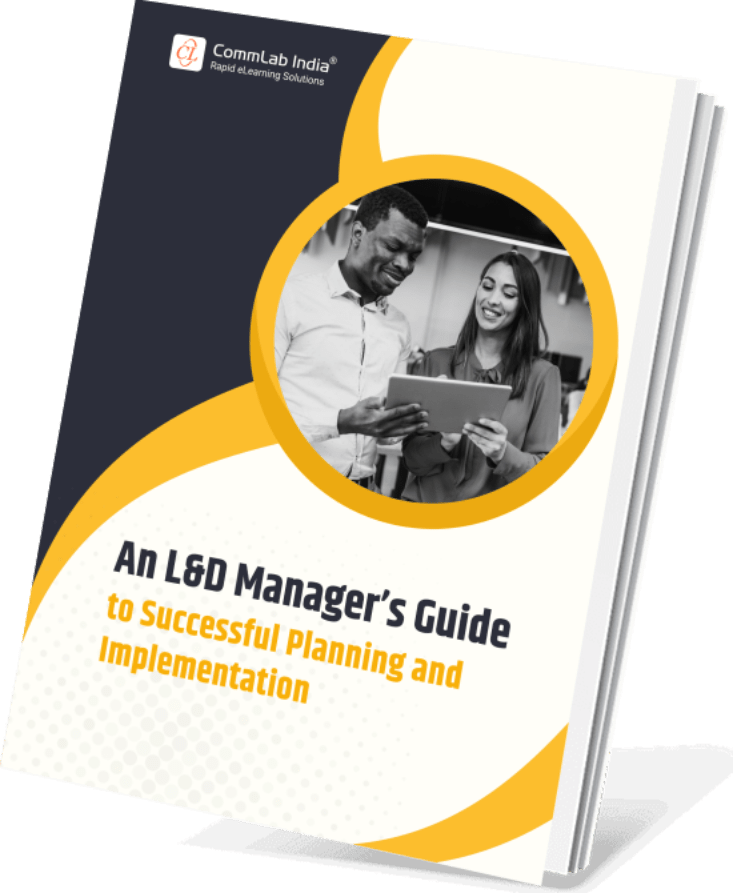Bridge Skills Gaps and Boost Career Growth with Effective Technical Training

In the relentlessly evolving world of business, technical skills hold the key to staying competitive and achieving career growth. As technology transforms the way we work, having a strong foundation in the right technical abilities can give you the edge you need to excel in your chosen field. That means having a highly skilled workforce that can keep up with new technologies and evolving business practices. But there's a challenge – the skills gap, a mismatch between job role requirements and employee skills.

This blog will help you explore the importance of technical training, highlight in-demand skills for various industries, and mention innovative approaches for effective technical skill development in corporate settings.
→ Download eBook: An L&D Manager’s Implementation Guide
L&D covers all the efforts made by an organization to boost its employees' knowledge, skills, and abilities. These programs don't just benefit individuals; they also significantly impact a company's overall success.
L&D is vital for addressing skills gaps to -
- Fill Current Skill Gaps: Skills gaps occur when what employers need doesn't align with what employees possess. By investing in corporate training programs that target areas where employees lack proficiency, organizations can bridge these gaps effectively.
- Prepare for Future Needs: With rapid technological advancements happening daily, new skill requirements constantly emerge in different industries. Continuous L&D initiatives help employees stay prepared for what's coming next.
Table Of Content
- Skills : The Key to Success in a Tech-Driven World
- Technical Skills in High Demand
- Role of Technical Training in Bridging Skills Gaps
- Transforming Technical Training with Modern Formats
- Challenges Faced in Implementing Technical Training
- Real-World Technical Training Success Stories
Why Technical Skills Matter: The Key to Success in a Tech-Driven World
Want to Understand Why Technical Training is Essential for Career Development?
Here are a few benefits of it:
1. Increased productivity and efficiency
2. Enhanced innovation and problem-solving
3. Adaptability in a changing workplace
4. Improved collaboration
5. Clearer career progression
Technical skills are the specialized knowledge and abilities needed to perform specific tasks and roles within an organization.
According to a Gartner survey, 85% of business leaders agree that the need for skills development will dramatically increase due to AI and digital trends.
Here's why they are crucial for professionals in today's corporate world:
1. Increased productivity and efficiency
Technical skills allow individuals to use the latest tools and technologies proficiently, leading to faster workflows and better outcomes.
2. Enhanced innovation and problem-solving
Strong technical foundations enable employees to think outside the box, develop creative solutions, and drive innovation within their teams and organizations.
3. Adaptability in a changing workplace
As technology advances, training in technical skills keeps professionals up-to-date, helping them navigate evolving job requirements and industry trends.
4. Improved collaboration
Sharing technical expertise can streamline workflows, communication, and successful project execution across multi-disciplinary teams.
5. Clearer career progression
Training in technical skills enhances your skillset, making you a more valuable asset, unlocking opportunities for advancement and increased earning potential.
Discover how technical training equips your team with the skills they need to excel in their roles and drive success!
The Evolving Landscape of Technology: Skills in High Demand
The specific technical skills required vary by industry and job role. However, some skills are in high demand across multiple sectors:
1. Programming Languages:
Proficiency in languages like Python, Java, JavaScript, C++, or industry-specific options is essential for a wide range of positions in software development, web development, and data science.
2. Data Analysis and Visualization:
Skills in handling and interpreting large datasets with tools like Excel, SQL, and visualization software like Tableau or Power BI are valuable across areas like business analysis, finance, and marketing.
3. Cloud Computing:
An understanding of cloud platforms like Amazon Web Services (AWS), Microsoft Azure, or Google Cloud Platform is increasingly sought-after in IT, development, and data management roles.
4. Cybersecurity:
As the need for data protection grows, skills in network security, ethical hacking, and cybersecurity principles are becoming critical for many organizations. As a bonus, here are a few steps to ensure mobile data security.

5. Digital Marketing:
Knowledge of social media platforms, search engine optimization (SEO), content marketing, email marketing, and analytics tools are vital for success in digital marketing roles.
6. Artificial Intelligence and Machine Learning:
A general understanding of these concepts, along with the ability to work with AI/ML-powered tools, is becoming more significant across industries.
Role of Technical Training in Bridging Skills Gaps
Technical training equips individuals with practical, job-relevant knowledge and skills, contrasting traditional academic education. It readies individuals for real-world applications. The role of technical training in addressing skills gaps is pivotal, fulfilling the demand for specialized skills not readily available in the job market. It's hands-on, practical learning, allowing immediate application. These programs align with industry needs, enhancing employability. Flexibility, with customizable options, accommodates working professionals and those with commitments.

An L&D Manager's Guide to Successful Planning & Implementation.
Learn:
- What Challenges do L&D Managers Face?
- How to Align Business and Project?
- How to be a Learning Consultancy?
- DOWNLOAD NOW!
Transforming Technical Training with Modern Formats
Traditional classroom-based training approaches are often not the most effective way to develop technical skills in a fast-paced corporate environment. Modern training formats offer flexibility, personalization, and a focus on practical application:
1. eLearning Platforms:
Online learning platforms provide a wealth of structured courses, video tutorials, and interactive modules covering a wide array of technical skills. These platforms offer convenient self-paced learning.
2. Virtual Labs and Simulations:
Hands-on practice is crucial for mastering technical skills. Virtual labs and simulations offer safe environments to experiment, practice, and troubleshoot within realistic scenarios.
3. Gamification:
Incorporating game elements into training can boost engagement and make learning more enjoyable, helping with knowledge retention and skill acquisition.
4. AI-Powered Learning:
AI-powered learning systems can personalize training paths, offering customized recommendations based on the individual's learning needs and progress, leading to more efficient skill development. Modern LXPs are a good example of platforms that provide AI-powered learning.

5. Microlearning:
Breaking down complex technical concepts into smaller, easily digestible chunks makes learning more manageable and helps employees fit training into their busy schedules. Microlearning solutions also help to cater to the short attention spans of the younger generation.
6. Mentorship Programs:
Pairing employees with more experienced colleagues provides guidance, support, and on-the-job skill development opportunities.
Challenges Faced in Implementing Technical Training (and How to Overcome Them)
Technical training plays a crucial role in bridging the skills gap and equipping employees with the necessary technical skills to excel in their roles. However, implementing advanced technical training programs can come with its own set of challenges.
Let's discuss some common challenges faced in implementing technical training and ways to overcome them.

1. Lack of Resources:
One of the biggest challenges faced by organizations when it comes to implementing technical training is a lack of resources. This includes both financial resources as well as human resources. Designing and delivering effective technical training programs requires a significant investment of time, money, and expertise.
Solution: To overcome this challenge, organizations can consider partnering with external training providers who specialize in delivering training in technical skills. This can help reduce costs while also providing access to expert trainers and resources. Additionally, leveraging eLearning platforms or utilizing internal subject matter experts for delivery can also be cost-effective solutions.
2. Resistance to Change:
Another common challenge is resistance from employees towards learning new skills or processes. Employees may feel comfortable with their current level of knowledge and may resist investing time and effort into acquiring new technical skills.
Solution: To address this challenge, it is important for organizations to create awareness among employees about the benefits of upskilling through targeted communication strategies. Providing clear explanations about how the new skills will benefit not just the organization but also the individual's career growth can motivate employees to embrace change.
3. Outdated Training Content:
Technical training programs need to be regularly updated to keep up with the constantly evolving industry trends and technologies. However, many organizations struggle with outdated training content that does not align with current industry practices.
Solution: To overcome this challenge, organizations should establish a process for regularly reviewing and updating their training materials. This can involve seeking feedback from employees, conducting research on industry trends, and collaborating with subject matter experts to ensure the training content remains relevant and up-to-date.
4. Lack of Relevancy:
Technical training programs may not always address the specific needs of employees or the organization's objectives. This can result in a lack of engagement and relevance for the learners.
Solution: To make training in technical skills more relevant, organizations should conduct a needs analysis to identify the skills gaps within their workforce. Based on this analysis, they can tailor their training programs to address specific skill deficiencies and align them with organizational goals.
5. Limited Time and Availability:
Employees often have busy schedules and finding time for training may seem like a daunting task. This can lead to low attendance rates and hinder the impact of the training program.
Solution: To overcome this challenge, organizations can offer flexible learning options such as self-paced online courses or microlearning modules that employees can access at their convenience. Additionally, breaking down training into smaller, bite-sized modules can make it more manageable for employees to fit into their schedules.

An L&D Manager's Guide to Successful Planning & Implementation.
Learn:
- What Challenges do L&D Managers Face?
- How to Align Business and Project?
- How to be a Learning Consultancy?
- DOWNLOAD NOW!
Real-World Technical Training Success: How Custom eLearning Solutions Made an Impact
1. Streamlined Software Training for a New RDMS
CommLab India tackled the challenge of providing role-based software training for 2,000 global employees on a new RDMS, even while the system was under review and constant updates. By creating a blended solution—featuring classroom sessions, Webex, eLearning, simulations, and quick reference guides—they ensured employees across the US, Europe, and Japan could use the system seamlessly from day one.
2. Engaging Training for Service Sales Planning Process
To introduce employees to a new planning process, CommLab India designed video-based eLearning courses that combined real employee videos with animated content, creating an engaging experience that motivated learners to complete the training. The creative mix of real and animated elements, including avatars of real employees, achieved impressive completion rates.
3. Investing in the Future: The Importance of Continuous Learning
The world of technology is constantly changing, and so must our skills. Investing in technical training is an investment in the future—both for individual employees and the organization as a whole. By fostering a culture of continuous learning and providing the necessary opportunities for technical skills development, companies can:
- Build a skilled and adaptable workforce: Ensure employees have the expertise to embrace innovation and keep up with industry advancements.
- Enhance competitiveness: Stay ahead of the curve by capitalizing on the latest technologies and trends, driving organizational success.
- Boost employee satisfaction and retention: Demonstrate a commitment to employee development, leading to higher job satisfaction and greater loyalty.
The Takeaway
In the dynamic landscape of the corporate world, technical skills are no longer optional, they are a passport to success. By embracing modern corporate technical training solutions, focusing on in-demand skills, and promoting a culture of continuous learning, organizations can empower their employees to not only keep up with the pace of technology but also drive innovation and growth.
Successful implementation starts with careful planning, alignment with company goals, and leveraging the right tools and resources to ensure training programs are impactful and scalable. Ready to take your learning and development strategy to the next level? Download our eBook, An L&D Manager’s Guide to Successful Planning and Implementation and get step-by-step insights to create a winning plan for your organization!





![How to Make Technical Training Fun & Engaging? [Strategies Decoded]](https://blog.commlabindia.com/hubfs/blogs/technical-training-strategies-increased-engagement%20.jpg)
![How Multiple Industries Can Utilize Digital Learning for Technical Training [Video]](https://blog.commlabindia.com/hubfs/digital-learning-multiple-industries-video.jpg)
![How to Spice Up Technical Training? Discover Engagement Strategies [Infographic]](https://blog.commlabindia.com/hubfs/blogs/technical-training-how-to-make-engaging-info.jpg)